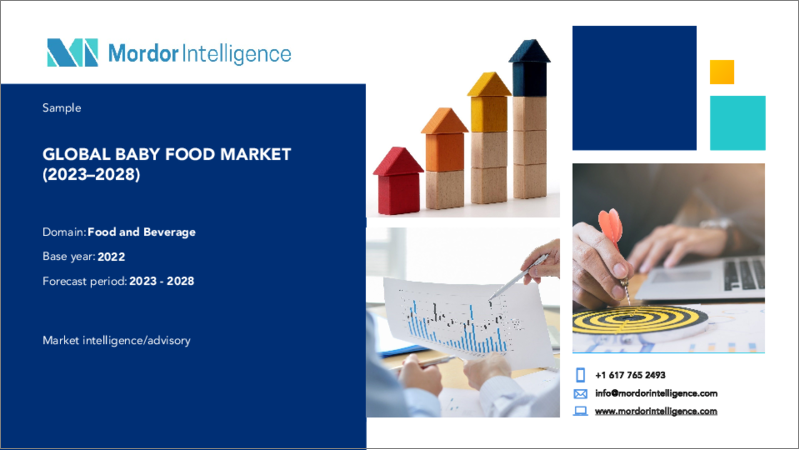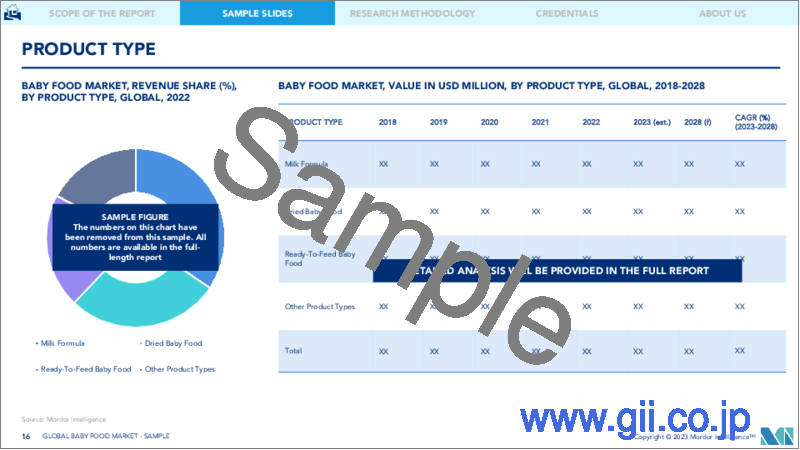|
|
市場調査レポート
商品コード
1190014
ベビーフード市場- 成長、動向、予測(2023年~2028年)Baby Food Market - Growth, Trends, and Forecast (2023 - 2028) |
||||||
|
● お客様のご希望に応じて、既存データの加工や未掲載情報(例:国別セグメント)の追加などの対応が可能です。 詳細はお問い合わせください。 |
|||||||
| ベビーフード市場- 成長、動向、予測(2023年~2028年) |
|
出版日: 2023年01月18日
発行: Mordor Intelligence
ページ情報: 英文 110 Pages
納期: 2~3営業日
|
- 全表示
- 概要
- 目次
ベビーフード市場は、予測期間中に3.67%のCAGRで推移すると予測されています。
働く女性人口の増加や可処分所得の増加も、ベビーフード市場の成長を後押ししています。乳幼児人口の増加やベビーフード製品およびその栄養価に関する認知度が、ベビーフード製品の需要をさらに押し上げています。さらに、多くの新興国や低開発国では、乳幼児が栄養失調や飢餓の問題を抱えているため、ベビーフードの市場も将来的に拡大すると予想されています。
国連国際児童基金(UNICEF)によると、世界の5歳未満児の死因の半分は栄養失調であるとされています。ヒト乳オリゴ糖(HMO)やプロバイオティクスなどの主要成分の革新により、市場の成長が期待されています。最近、有機ベビーフードの需要が増加しています。これは、働く女性の増加に起因しています。このような便利な食品は需要が多いため、需要の増加により市場が伸びています。
家事の時間が限られているため、現代の家庭では、こうした便利で栄養価の高いパッケージのベビーフードを利用することが多くなっています。長期的には、メーカーは乳幼児期から免疫システムをサポートする製品の開発を進めています。市場の主要企業は、親や乳幼児にとってより魅力的な新製品を常に発表しており、市場の成長を後押ししています。例えば、2022年7月、英国に本拠を置くOrganix社は、2つの新しい有機乳幼児食シリーズを発売しました。ベビーミール」と「オーガニックス・キッズ」です。これらは、Asdaとそのオンラインストアで販売されています。
主な市場動向
働く女性がRTEベビーフードの需要を牽引している
働く女性の増加や簡便な食品へのシフトにより、オーガニックベビーフードの需要が拡大し、オーガニックベビーフード市場を牽引しています。現代の家計はパラダイムシフトが起きており、多くの大人が家事、特に食事の準備や調理に多くの時間を必要とするようになりました。その結果、すぐに食べられる食品、または包装された食品の需要が高まっています。さらに、働く女性、特に新米ママは、すぐに食べられる食事アイテムを好みます。これらの働く母親は、時間の節約になり、家事をこなしながらワークライフバランスを保つことができるため、子供のために包装された食品を選択するのです。
働く女性は子供の栄養を優先し、ベビーフードを選んでいるため、ベビーフード分野が拡大しているのです。国家統計局(ONS)によると、2021年9月、イングランドでは75.6%の母親が働いており、2018年の74%から上昇しました。さらに、世界銀行のデータでは、2021年、インドの労働力人口は2020年の18.6%から19.23%に増加しました。
アジア太平洋地域が主要なシェアを占める
ベビーフード市場では、アジア太平洋地域が非常に大きなシェアを占めています。世界的に見ても最大規模であり、最も成長率の高い市場です。人口の増加、多忙なライフスタイル、個人消費の増加により、今後数年間は非常にダイナミックな市場となることが予想されます。この地域では中国が最大の市場です。また、インドやインドネシアなどの新興国も、アジア太平洋地域の市場成長を牽引するものと期待されています。近代的な小売店の浸透、製品認知度の向上、可処分所得の増加、購買力の向上が、この地域のベビーフード市場の開拓に影響を与えています。ドラッグストア/薬局などの非食品専門小売店が消費者に好まれるチャネルであり、オンラインチャネルは最も急速に成長している流通チャネルです。
ベビーフード市場は、ビーガンベースの食品が動向となっています。赤ちゃんがビーガンベースのベビーフードを食べることは、安全で栄養価が高いと考えられています。ベビーフードメーカーは、成長するビーガン市場に対応するため、ビーガンベースの製品を発売しています。例えば、2022年7月、中国初のカーボンニュートラル製品として、Nestleは除草剤や成長ホルモンを使用しないスイスの農場から供給された幼児用ステージ3フォーミュラを発売しました。
競合情勢
ベビーフード市場は、各国の有力な地域・国内企業が存在するため、競争が激しいです。企業は、消費者の間でブランドの存在感を高めるために、合併、拡張、買収、提携、新製品開発に注力しています。ベビーフード市場の大手企業は、Nestle SA、Danone SA、Reckitt Benckiser Group PLC、Abbott Laboratories、Feihe International Inc、Royal FrieslandCampina NV、Shijiazhuang Junlebao Dairy、Ausnutria Dairy Corporation Ltd、Yili Group、およびThe Kraft Heinz Companyが挙げられます。近年、プレイヤーは乳幼児食品事業で強力な地位を獲得するため、製品の上市や認可取得に積極的に取り組んでいます。
2021年4月、Kraft Heinz Companyは、新生児に高品質のビーガン食を与えるための植物性ベビーフードラインを開発しました。この食品ラインには、豆とニンジンを使った「ソーシーパスタスターズ」、インゲン豆とスイートガーデンピーを使った「ポテトベイク」、ひよこ豆とかぼちゃを使った「リゾット」などがあります。
その他の特典。
- エクセル形式の市場予測(ME)シート
- アナリストによる3ヶ月間のサポート
目次
第1章 イントロダクション
- 調査の前提条件と市場の定義
- 調査対象範囲
第2章 調査手法
第3章 エグゼクティブサマリー
第4章 市場力学
- 市場促進要因
- 市場抑制要因
- ポーターのファイブフォース分析
- 供給企業の交渉力
- 買い手/消費者の交渉力
- 新規参入業者の脅威
- 代替品の脅威
- 競争企業間の敵対関係
第5章 市場セグメンテーション
- カテゴリー別
- オーガニック
- 従来品
- タイプ別
- 粉ミルク
- 乾燥ベビーフード
- レトルトベビーフード
- その他のタイプ
- 流通経路別
- ドラッグストア/薬局
- スーパーマーケット/ハイパーマーケット
- コンビニエンスストア
- オンラインチャネル
- その他の流通チャネル
- 地域別内訳
- 北米
- 米国
- カナダ
- メキシコ
- その他北米地域
- 欧州
- 英国
- ドイツ
- スペイン
- フランス
- イタリア
- ロシア
- その他欧州
- アジア太平洋地域
- 中国
- 日本
- インド
- オーストラリア
- その他アジア太平洋地域
- 南米
- ブラジル
- アルゼンチン
- その他の南米地域
- 中東・アフリカ地域
- 南アフリカ
- サウジアラビア
- その他中東・アフリカ地域
- 北米
第6章 競合情勢
- 最も採用されている戦略
- 市場シェア分析
- 企業プロファイル
- Nestle SA
- Danone SA
- Reckitt Benckiser Group PLC
- Abbott Laboratories
- Feihe International Inc.
- Royal FrieslandCampina NV
- Shijiazhuang Junlebao Dairy Co. Ltd
- Ausnutria Dairy Corporation Ltd
- Yili Group
- The Kraft Heinz Company
第7章 市場機会と今後の動向
The baby food market is projected to register a CAGR of 3.67% during the forecast period.
The increasing working female population and rising disposable income are also aiding the market growth for baby food. The rising infant population and awareness about baby food products and their nutritional values further boost the baby food product demand. Moreover, because of the existing malnutrition and hunger issues facing infants in many developing and underdeveloped countries, the market for baby food is also set to grow in the future.
According to the United Nations International Children's Security Fund (UNICEF), malnutrition contributes to half of all deaths among children under five worldwide. The market expects growth amid innovations with key ingredients, such as human milk oligosaccharides (HMOs) and probiotics. Recently, there is an increase in the demand for organic baby food. It can be attributed to the number of women working increased. These convenient foods are in great demand, resulting in growth in the market due to the increased demand for them.
As a result of limited time for housekeeping, modern households are increasingly using these convenient and nutritious packaged baby foods. Over the long term, manufacturers are developing products that support the immune system from infancy. Key players in the market are constantly launching new products to make them more appealing to parents and infants, aiding the market's growth. For instance, in July 2022, United Kingdom-based Organix launched two new organic baby and toddler food ranges: Baby Meals and Organix Kids. They are available through Asda and its online store.
Key Market Trends
Working Women are Driving the Demand for RTE Baby Food
The demand for organic baby food is expanding due to an increase in working women and a quick shift toward convenience foods, propelling the organic baby food market. There is a paradigm shift in the organization of modern households, with most adults needing more time for home administration, particularly food preparation and cooking. As a result, there is a rise in the demand for ready-to-eat or packaged foods. Furthermore, working women, particularly new mothers, prefer ready-to-eat meal items. These working mothers choose packaged food items for their children as it saves time and allows them to maintain a work-life balance while still taking care of domestic obligations.
Working women are prioritizing their children's nutritional requirements and choosing manufactured baby meals, thus expanding the baby food sector. According to the Office for National Statistics (ONS), in September 2021, 75.6% of mothers in England were working, up from 74% in 2018. Furthermore, as per World Bank data, in 2021, India's labor force increased to 19.23% from 18.6% in 2020.
Asia-Pacific Holds the Major Share
Asia-Pacific holds a very significant share of the baby food market. It is the largest and fastest-growing market globally. It is expected to be very dynamic in the coming years, owing to its growing population, hectic lifestyles, and rising consumer spending. China is the largest market in the region. Moreover, developing countries like India and Indonesia are expected to drive the market's growth in Asia-Pacific. The rising modern retail penetration, product awareness, rising disposable incomes, and purchasing power are influencing the baby food market development in the region. Non-grocery specialist retailers, such as drugstores/pharmacies, are the preferred channel for consumers, and online channels are the fastest-growing distribution channel.
The baby food market is trending towards vegan-based foods. It is considered safe and nutritious for babies to eat vegan-based baby food. Baby food manufacturers are launching vegan-based products to cater to the growing vegan market. For instance, in July 2022, As China's first carbon-neutral product, Nestle launched a stage three formula for toddlers sourced from a Swiss farm that does not use herbicides and growth hormones.
Competitive Landscape
The market for baby food is competitive due to prominent regional and domestic players in different countries. Companies are focusing on mergers, expansions, acquisitions, partnerships, and new product developments to boost their brand presence among consumers. A few leading companies in the baby food market are Nestle SA, Danone SA, Reckitt Benckiser Group PLC, Abbott Laboratories, Feihe International Inc., Royal FrieslandCampina NV, Shijiazhuang Junlebao Dairy Co. Ltd, Ausnutria Dairy Corporation Ltd, Yili Group, and The Kraft Heinz Company. Recently, players have been active in product launches and approvals to gain a powerful position in the infant food business.
In April 2021, the Kraft Heinz Company developed a plant-based baby food line to give newborns a high-quality vegan diet. The food line includes Saucy Pasta Stars with beans and carrots, Potato Bake with green beans and sweet garden peas, and Risotto with chickpeas and pumpkin.
Additional Benefits:
- The market estimate (ME) sheet in Excel format
- 3 months of analyst support
TABLE OF CONTENTS
1 INTRODUCTION
- 1.1 Study Assumptions and Market Definition
- 1.2 Scope of the Study
2 RESEARCH METHODOLOGY
3 EXECUTIVE SUMMARY
4 MARKET DYNAMICS
- 4.1 Market Drivers
- 4.2 Market Restraints
- 4.3 Porter's Five Forces Analysis
- 4.3.1 Bargaining Power of Suppliers
- 4.3.2 Bargaining Power of Buyers/Consumers
- 4.3.3 Threat of New Entrants
- 4.3.4 Threat of Substitute Products
- 4.3.5 Intensity of Competitive Rivalry
5 MARKET SEGMENTATION
- 5.1 By Category
- 5.1.1 Organic
- 5.1.2 Conventional
- 5.2 By Type
- 5.2.1 Milk Formula
- 5.2.2 Dried Baby Food
- 5.2.3 Ready to Feed Baby Food
- 5.2.4 Other Types
- 5.3 By Distribution Channel
- 5.3.1 Drugstores/ Pharmacies
- 5.3.2 Supermarkets/ Hypermarkets
- 5.3.3 Convenience Stores
- 5.3.4 Online Channels
- 5.3.5 Other Distribution Channels
- 5.4 By Geography
- 5.4.1 North America
- 5.4.1.1 United States
- 5.4.1.2 Canada
- 5.4.1.3 Mexico
- 5.4.1.4 Rest of North America
- 5.4.2 Europe
- 5.4.2.1 United Kingdom
- 5.4.2.2 Germany
- 5.4.2.3 Spain
- 5.4.2.4 France
- 5.4.2.5 Italy
- 5.4.2.6 Russia
- 5.4.2.7 Rest of Europe
- 5.4.3 Asia-Pacific
- 5.4.3.1 China
- 5.4.3.2 Japan
- 5.4.3.3 India
- 5.4.3.4 Australia
- 5.4.3.5 Rest of Asia-Pacific
- 5.4.4 South America
- 5.4.4.1 Brazil
- 5.4.4.2 Argentina
- 5.4.4.3 Rest of South America
- 5.4.5 Middle-East and Africa
- 5.4.5.1 South Africa
- 5.4.5.2 Saudi Arabia
- 5.4.5.3 Rest of Middle-East and Africa
- 5.4.1 North America
6 COMPETITIVE LANDSCAPE
- 6.1 Most Adopted Strategies
- 6.2 Market Share Analysis
- 6.3 Company Profiles
- 6.3.1 Nestle SA
- 6.3.2 Danone SA
- 6.3.3 Reckitt Benckiser Group PLC
- 6.3.4 Abbott Laboratories
- 6.3.5 Feihe International Inc.
- 6.3.6 Royal FrieslandCampina NV
- 6.3.7 Shijiazhuang Junlebao Dairy Co. Ltd
- 6.3.8 Ausnutria Dairy Corporation Ltd
- 6.3.9 Yili Group
- 6.3.10 The Kraft Heinz Company




